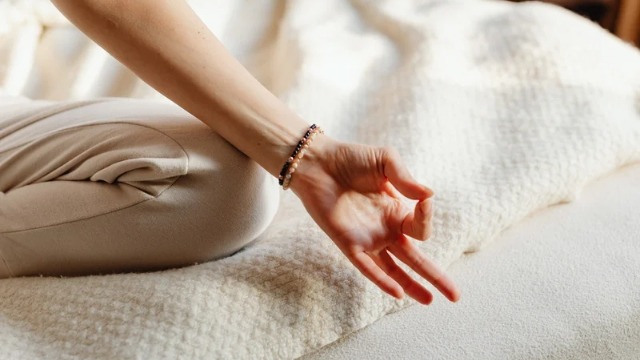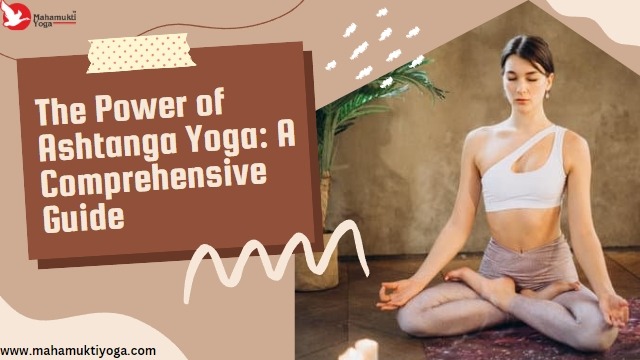K. Pattabhi Jois popularized Ashtanga Yoga, also known as Ashtanga Vinyasa Yoga, a contemporary form of yoga in the 20th century. The ancient yoga teachings, which originated in India more than 5,000 years ago, serve as the foundation for this style of yoga.
Asanas, or postures, are performed in a predetermined order in Ashtanga Yoga, a dynamic and physically demanding practice. Ujjayi breathing, bandhas (energy locks), and drishti (gaze) are also used to improve focus and concentration in the practice.
Ashtanga means “eight-limbed” in Sanskrit (asta-eight, anga-limb). The eight-step Ashtanga Yoga path leads to the state of yoga, also known as Samadhi.
The Yoga Sutras of Patajali, an ancient text on the theory and practice of Yoga thought to have been compiled by Sage Patajali around 200 CE, contain the definition of Ashtanga Yoga.
The Yoga Sutras of Patajali are a collection of four books and 196 short philosophical statements on the theory and practice of yoga. The Yoga Sutras are so concise and are thusly practically tremendous without discourse. Veda Vyasa’s commentary is the most authoritative; The Yoga Bhasya is the name of his commentary.
The Yoga Sutras start with the most noteworthy lessons first, for those prepared to go into the last appendages of training. The following is the definition of yoga that is provided to us in the second sutra of the first chapter, Samadhi Pada: Yogas citta vritti nirodah, or “Yoga is the cessation of mind fluctuations,” can be translated as follows: When the mind is still, which is the Yoga state, the individual mind and individual consciousness are one with the Universal Mind, and we experience our divinity through unity.
The eight elements of yoga practice outlined in Patanjali’s Yoga Sutras are referred to as “eight limbs,” and the term “ashtanga” means “eight limbs.”
The definition of the eight-limbs path that leads to yoga can be found in the chapter on yoga practice in book two of Patajali’s Yoga Sutras, Sadhana Pada. In Sutra 2.29, it says, Yama-niyama-asana-pranayama-pratyahara-dharana-dyana-samadhyaya-astavangani.” This could be written as follows: Yin, niyama, asana, pranayama, pratyahara, dharana, dhyana, and samadhi are the eight limbs of yoga.
Also Read: Do you want to become a 200 hour yoga teacher from Goa
The Eight Limbs of Ashtanga Yoga
The first two limbs of Ashtanga Yoga, yama and niyama, are moral and ethical principles that instruct the practitioner in leading a virtuous life.
The other six limbs are as follows:
- Asana: physical postures
- Pranayama: breathing techniques
- Pratyahara: withdrawal of the senses
- Dharana: concentration
- Dhyana: meditation
- Samadhi: union with the divine
Benefits of Ashtanga Yoga
- Boosts the Body’s Stamina: The practice of Ashtanga Yoga is physically demanding and calls for endurance and strength. It aids in muscle growth and enhances overall physical fitness.
- Increases Flexibility: A series of postures that stretch and strengthen the muscles, tendons, and ligaments are part of Ashtanga Yoga. This can result in improved mobility and flexibility when practiced regularly.
- Improves Focus and Concentration: As practitioners move through a predetermined sequence of postures while synchronizing their breath, Ashtanga Yoga requires a great deal of concentration and focus. Concentration, focus, and mental clarity may all benefit from this.
- Reduces Stress and Anxiety: By doing Ashtanga yoga you can reduce stress and anxiety because it involves deep breathing and meditation. This yoga involves self-awareness, which can help to improve emotional will being.
- Boosts Immune System: By reducing stress and improving physical health as a whole, Ashtanga Yoga can help strengthen the immune system when practiced regularly.
- Improves Digestion: Ashtanga Yoga postures can help to stimulate the digestive system, improving digestion and relieving constipation.
Practice of Ashtanga Yoga:

- Asanas, or postures, are linked together in a predetermined order in Ashtanga yoga.
- The practice comprises six sequences of postures, each one more challenging than the previous one.
- The Primary Series of yoga focuses on building both strength and flexibility in the body.
- Each pose is held for a duration of five breaths before progressing to the next posture.
- The training is normally done in a heated room to promote sweating and detoxification.
- Meditation and pranayama, or controlled breathing exercises, are integral parts of yoga practice. These methods help to relax and calm the mind.
Also Read: Do you want to become a 300 hour yoga teacher from Goa
Can beginners do ashtanga yoga?
Ashtanga is not the best type of yoga for beginners to practice because it is complicated, precise, and physically challenging. However, beginners are still welcome to begin. You’ll be able to clearly see your progress and improvements thanks to the specific and structured movements it offers. Additionally, it is helpful because the primary sequences begin with poses and movements that are more appropriate for beginners. The primary series, also referred to as Yoga Chikitsa or Yoga Therapy, focuses on centering and preparing the body for the subsequent, more challenging series. It’s also great for knowing when you’re doing your asanas right because Mysore-style classes emphasize individual instruction.





